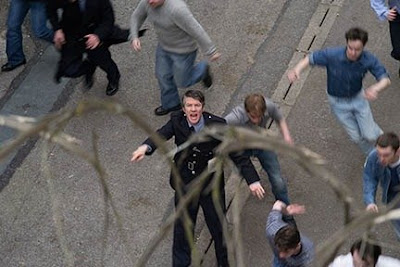That title, BEFORE HOMOSEXUALS, is not exactly true -- as there was no time in human history, so far as anyone can figure, that homosexuals did not exist. They simply weren't called by that term. The condition seems to have arrived with the species (and not simply our own).
This new documentary -- which has the look, sound and feel of a somewhat rushed job, in order to get it out there in time for this year's gay pride events -- takes a fairly interesting look at the earliest artistic depictions of homosexual acts between men and women, from caveman days through ancient Egypt, Greece and Rome, and then into later times, from the Victorians onwards until we get to, yes, Stonewall once again (that last could hardly be considered a time "before homosexuals").
As directed, co-produced and co-written by, and starring John Scagliotti (shown, right, and at bottom) as our sort-of host and guide, the documentary skips and jumps all over the place, from location to time period, as it unearths the many depictions of lesbian and gay sexual behavior down the centuries.
These are generally interesting and fun to view -- unless, of course, one is among the currently hypocritically pro-Trump evangelicals -- while the several talking heads on view have intelligent things to offer, as well.
Some of the film's editing seems a bit strange, never more so than when one person reads from Michelangelo's poetry, only to have that reading constantly cut into by new visuals and other people talking.
Along the way we are asked a pertinent question by Louis Crompton, to whom -- along with the many other LGBT historians -- the film is dedicated: Who gets to define and analyze history? We learn the answer (not, for way too many decades, the LGBT population), even as we discover some spicy details: how very naughty a city and a populace was Florence and its Florentines.
The trip is mostly engaging, and Scagliotti proves an amiable enough host, though one might question why we need to have his marriage ceremony included here, except to boost the running time to full-length status.
Overall, the documentary has a let's-get-it-finished-and-out-there quality that, for all its detail and look at various artwork and sculpture, makes it seem, although the film had in premiere in Boston back in 2017, that the main goal was to have Before Homosexuals ready in time for the June LGBT celebrations.

In any case, the film makes a decent addition to the current festivities, with a DVD, as well as digital viewing via iTunes and Amazon, available now. Distributed by First Run Features, the documentary boasts a running time of 87 minutes.
























































